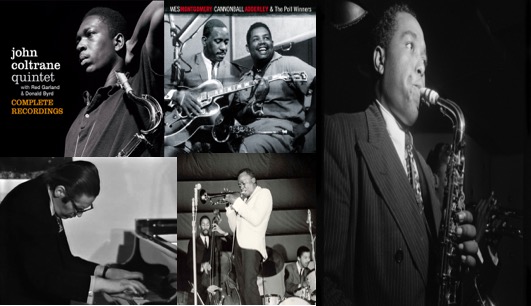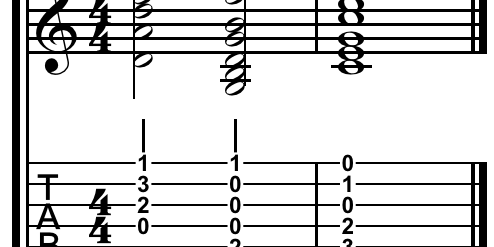
After learning how arpeggios are used to improvise and exploring the foundations of improvisation, it’s important to learn from the great improvisers and how they applied the theory so that we can reproduce these techniques in a musical and more authentic way. One of the best ways to start internalizing the jazz language is to transcribe these great musicians. By transcribing we develop not only our ear, but it also allows us to train our muscle memory to feel swing, accents, and particular passages that are very common in, and are a crucial part of jazz music from a range of musicians over the last century. The task of transcribing doesn't need to involve sitting down for weeks at a time, writing out a Charlie Parker solo note-by-note, but can be as simple as listening to some music, stopping it when you hear something you like, and trying to emulate that sound. It could be a phrase or even just a couple of notes, and of course it’s not always necessary to transcribe it to paper, it’s more about ear training than writing a book. You will find you will internalise the bits you love and forget the bits you don’t, this is what builds your unique sound.
Progressions
We will focus on licks that are used over the progressions we have looked at over in the intro to jazz course: the ii V I and the I vi ii V. This way, it allows us to take the theory we have learned and see how great musicians are applying this theory in performance. The focus is not just on guitarists, but on all instrumentation, so look out for differences in the way a guitarist like Wes Montgomery approaches articulation and movement compared to the way a saxophonist like John Coltrane may play over the same progression. It's really interesting to see how the instrument we play actually has a big impact on how we improvise. Although we have looked at two progressions, the ii V I is part of the I vi ii V as it will often resolve back to a tonic chord anyway. This means that you can pull from both these progressions and adapt licks to fit.
When practicing the transcribed licks, make sure to listen to the original recording. This is because we are not just learning a bunch of notes, the goal of transcription is to emulate the feel, tone, groove, and volume of each note to recreate the lick as perfect as possible. Jazz improvisation is based on the feeling of the lines--not just the note choice.


1. John Coltrane (Tenor Saxophone) - “I’m Old Fashioned”
This beautiful line is based around the major scale, Eb major in this case. Notice there are three main points in this line, its starts on a Bb and runs down to the lower octave Bb, then resolves to the tonic.
This gives us the 5th of the Eb, the 11th of the Fm7 (this is called an extension), and then of course the tonic of the key (Eb). Coltrane’s line shows how powerful the use of just the major scale can be. When learning this line, focus on the groove and feel, try to emulate the way the line swings and the articulation, this is what gives it such a wonderful sound.
Learn with LPM
2. Wes Montgomery (Guitar) - “Polkadots and Moonbeams” 2:17
Wes montgomery is famous for his octave playing and this line uses this technique also; but to start, play as single notes. One way we can learn from this lick is by visually looking at the arch of the notation. Notice how the line moves up and down smoothly. One very common practice in jazz that is apparent here is going up an arpeggio and down a scale as you can see in bars one and two.
When practicing this line, try to use as much legato (hammer-ons and pull offs) as possible. This helps to achieve a smoother sound and emulates the sound of a saxophone. The rhythm in this line is quite complicated, so it’s best to listen to it first and take it slowly.
3. Charlie Parker (Alto Saxophone) - “Anthropology”

Charlie Parker is known for his ultra fast bebop lines that are surprisingly well thought out. This line is a great example of the use of a sequential motive. The first 4 notes are repeated at different pitches to create movement. Although some of the notes in this line are questionable in regards to the chords, the strength of this motive allows it to be very convincing. Most likely Charlie Parker was not thinking I-vi-ii-V, but thinking of the resolution point after this, for example starting from Bb and taking the line out and resolving it back to Bb or whatever chord is played after the two bars. This line has a lot of large interval jumps, so practice it slowly and use as much legato as possible.
4. Bill Evans (Piano) - “Waltz for Debby” 3:02

Bill Evans’ impressionistic approach to improvisation often involves the use of open sounding intervals like 5ths and 4ths. This line is a great example of how he uses these open intervals to create a very convincing sound. This, coupled with the rhythmic motif Bill uses, means it sits nicely in a tune and can be developed far beyond just this progression. Focus on the swing feel between the interval jumps, this is vital as it contributes immensely to the groovy sound of the lick.
5. Miles Davis (Trumpet) - “Four” 1:10

Miles Davis is often thought of as the most notable name in jazz. His improvisations defined movements and promoted the growth of jazz to what it is today. His use of space is something that is often talked about. This lick uses space simply, but effectively. It is a great example of ‘call and response,’ a compositional and improvisational technique used throughout all genres of music. Check out the movement of the line, this alone gives you a great visualisation of how it may sound and how the second phrase is an expansion of the first. It is not as arpeggio based as some of the others, but more scalic. The scales Davis uses in this lick is something that will be explored in future articles.
Conclusion
Although these lines differ greatly, they all outline the same chord progression. This means that we now know the scope of sound that we can use to improvise. Some artists use a lot of notes, or a lot of dissonance, and others use less of these things. Each of these techniques and traits gives each musician their signature sound. The three most important things to note on these is the feel, phrasing and where they are placing the chord tones (notes of the arpeggio). The swing feel and articulation is something we can emulate by playing along to the recording, this can be harder on some faster, more intricate lines, but is a good goal to put in place when transcribing. The next step is to try these out on a tune you are learning and transpose them into new keys.
More About the Teacher
Rowan Pattison is an Australian jazz and contemporary guitarist. His resumé boasts artists such as American singer Bobby Arvon (Happy Days), Broadway star Michelle Murlin, American Idol finalist Lou Gazzara, Marcus Terrel from America’s Got Talent, Vegas Trumpet prodigy Greg Bohnam and American Comedian James Stevens III, who is featured regularly on The Tonight Show and Comedy Central. Now based in Melbourne, Rowan has just lead his own trio concert Impressionism of Bill Evans on a tour of Europe playing concerts in Kyiv, Lviv, Krakow and Paris. Rowan's guitar courses with Liberty Park Music include the Introduction to Jazz Improvisation and Introduction to Solo Guitar.







